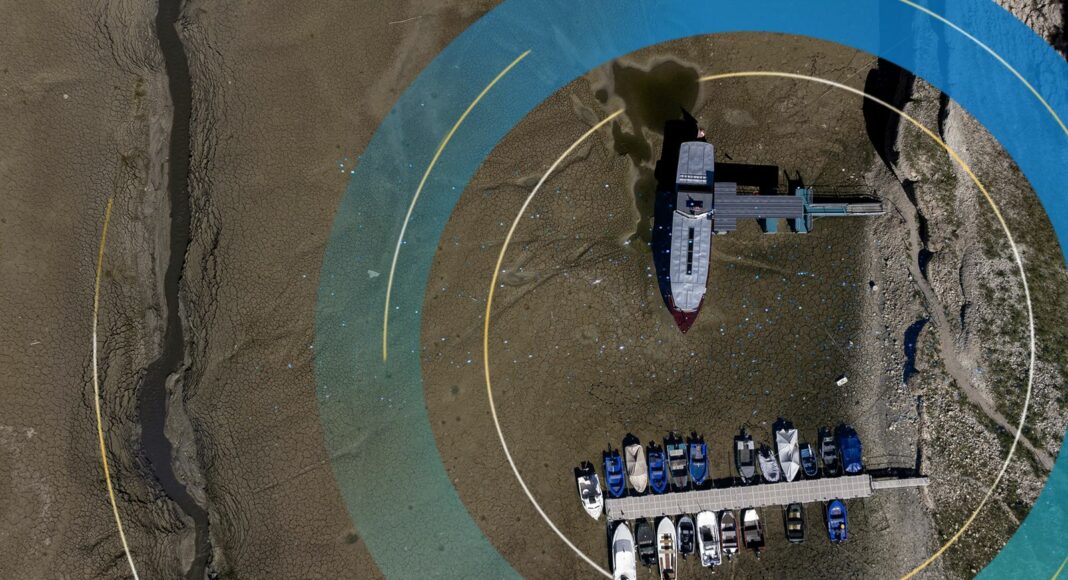Almost half of European Union land is currently under a drought warning or in the most severe “alert” status, hampering agriculture, energy production and water supply, the European Commission has confirmed.
From water handouts in France in the west and fish deaths in Serbia in the east, to an evaporating river in Germany and withering olive tress in Spain and Italy, much of the territory is suffering what is set to be its worst drought in a 500 year record.
Some 47% of the bloc’s land came under “warning” drought conditions – the second most severe drought category – during the 10 days leading to 30 July – new data released by the EC’s European Drought Observatory (EDO) confirmed on Tuesday evening.
More concerning is the 17% of land that hit the most severe “alert” status, up from 15%, meaning not only is soil drying out after low rain, but plants and crops are suffering too.
Image:
Some 47% of EU territory was under drought warning level and 17% hit alert status in the ten days to 30 July
Further dry weather forecasts for many countries in August and September “add concerns to the already very critical situation and, if confirmed, will exacerbate drought severity and the impacts on agriculture, energy and water supply”, the EDO warned in July.
Further heatwaves and little rain are on the horizon, but the longer-term forecast is more worrying, Andrea Toreti, senior researcher at the EC’s Joint Research Centre, who compiles the EDO data, said on Tuesday.
“Looking at the next three months, we see still a very high risk of dry conditions over western and central Europe, as well as the UK,” he told reporters.
“So this, I think, is causing more concern than just the forecasts of the coming few days.”
Image:
Fish have been dying due to shrinking water levels in Serbia
Water police
Water levels in rivers, lakes and reservoirs across western Europe are running low, or even dry, putting stress on drinking water supplies, hampering tourism and threatening crop yields, just as the war in Ukraine sent food prices shooting up.
Weeks of baking temperatures and scant rainfall have drained the water levels of the Rhine, Germany’s commercial artery, delaying shipping and pushing up freight costs more than five times.
Spanish reservoirs are at just 40% of capacity on average in early August, well below the ten-year average of around 60%, while a shrivelling lake in Serbia has seen hundreds of fish wash up dead.
French police are patrolling the streets of some areas to ensure that residents and businesses are not using water wastefully, as the country grapples with water shortages and another major wildfire.
Mr Toreti said that the areas affected by drought and lack of water will increase and that if effective mitigation measures are not taken “this intensity and frequency will increase dramatically over Europe, both in the north and in the south”.
Energy production hit
Russia’s latest invasion of its neighbour, and disrupting European gas supplies, also sent energy prices soaring and left countries looking to exploit home-grown energy.
But low river levels and higher water temperatures have also hindered energy production in some areas.
Water levels in reservoirs for hydropower are down in nine countries, including Italy, Serbia, Montenegro and Norway.
2:52
Rivers run low as drought continues in UK
Nuclear operator EDF last week reduced its power output at a plant in southwestern France due to high river temperatures on the Garonne, with half of its 56 reactors already offline due to maintenance or corrosion problems.
Climate breakdown is making drought in the Mediterranean more severe and more likely, although it is not to blame for all droughts.
Causes of drought are complex, but climate change affects it in two key ways. It concentrates rainfall into shorter and more intense bursts, making it harder to retain.
Hotter temperatures also evaporate more water – and heatwaves, which are “unilaterally” linked with global warming, also drive up demand as people seek to cool off.
Watch the Daily Climate Show at 3.30pm Monday to Friday, and The Climate Show with Tom Heap on Saturday and Sunday at 3.30pm and 7.30pm.
All on Sky News, on the Sky News website and app, on YouTube and Twitter.
The show investigates how global warming is changing our landscape and highlights solutions to the crisis.




